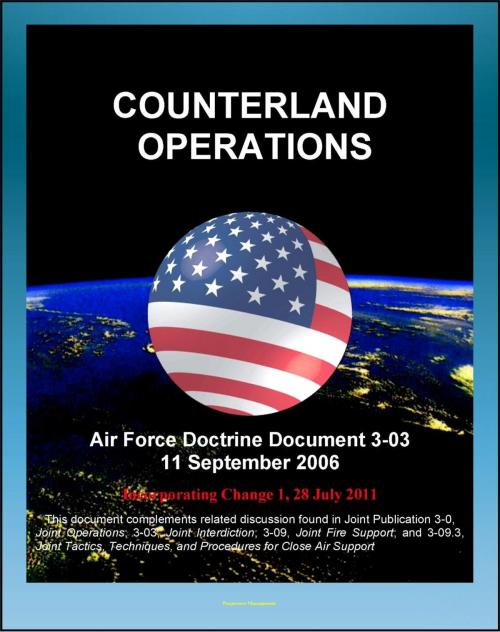Air Force Doctrine Document 3-03, Counterland Operations - USAF Air Interdiction (AI), Close Air Support (CAS), Battlespace Geometry, Kill Box Operations
Nonfiction, Science & Nature, Technology, Aeronautics & Astronautics, History, Military, Aviation| Author: | Progressive Management | ISBN: | 9781476306889 |
| Publisher: | Progressive Management | Publication: | April 11, 2012 |
| Imprint: | Smashwords Edition | Language: | English |
| Author: | Progressive Management |
| ISBN: | 9781476306889 |
| Publisher: | Progressive Management |
| Publication: | April 11, 2012 |
| Imprint: | Smashwords Edition |
| Language: | English |
Counterland operations dominate the surface environment by crushing an enemy's ability to fight on land. Through air interdiction, air and space power can divert, disrupt, delay, or destroy enemy military potential before it can be brought to bear against friendly ground forces, and achieve joint force commander objectives independently. Indeed, the devastation wrought on an enemy by air and space power may preclude costly ground combat. When called for, air and space power delivers devastating support to assist friendly ground forces in achieving their objectives.
Twenty-first century capabilities regarding precision, information technology, space, intelligence, and command and control increase counterland effectiveness. Modern counterland capabilities can help achieve objectives more efficiently than in the past. This provides commanders a flexible capability that makes other applications of military power more effective and may drive an early end to conflict.
When the objective is to destroy an enemy army's capability to fight, air and space power should always be considered as a first option. Air and space power has inherent, unique advantages in conducting counterland operations, but commanders should recognize they are more effective in conjunction with other forms of military action. In fact, other air and space power functions often complement counterland operations to produce operational level effects to destroy an enemy's warfighting capability.
Air Force Doctrine Document 2-1.3, Counterland Operations, is doctrine for understanding, planning, and executing this crucial air and space power function across the full range of military operations. Air Force personnel need to be able to articulate the rationale for counterland as a valuable warfighting option for the combatant commander. More importantly, Air Force personnel must understand how counterland operations can help enhance military strategies as a tool for defeating our nation's adversaries.
Contents: Chapter One - Counterland Fundamentals * Chapter Two - Air Interdiction * Chapter Three - Close Air Support * Chapter Four - Command and Control of Counterland Operations * Chapter Five - Conducting Counterland Operations
Counterland operations dominate the surface environment by crushing an enemy's ability to fight on land. Through air interdiction, air and space power can divert, disrupt, delay, or destroy enemy military potential before it can be brought to bear against friendly ground forces, and achieve joint force commander objectives independently. Indeed, the devastation wrought on an enemy by air and space power may preclude costly ground combat. When called for, air and space power delivers devastating support to assist friendly ground forces in achieving their objectives.
Twenty-first century capabilities regarding precision, information technology, space, intelligence, and command and control increase counterland effectiveness. Modern counterland capabilities can help achieve objectives more efficiently than in the past. This provides commanders a flexible capability that makes other applications of military power more effective and may drive an early end to conflict.
When the objective is to destroy an enemy army's capability to fight, air and space power should always be considered as a first option. Air and space power has inherent, unique advantages in conducting counterland operations, but commanders should recognize they are more effective in conjunction with other forms of military action. In fact, other air and space power functions often complement counterland operations to produce operational level effects to destroy an enemy's warfighting capability.
Air Force Doctrine Document 2-1.3, Counterland Operations, is doctrine for understanding, planning, and executing this crucial air and space power function across the full range of military operations. Air Force personnel need to be able to articulate the rationale for counterland as a valuable warfighting option for the combatant commander. More importantly, Air Force personnel must understand how counterland operations can help enhance military strategies as a tool for defeating our nation's adversaries.
Contents: Chapter One - Counterland Fundamentals * Chapter Two - Air Interdiction * Chapter Three - Close Air Support * Chapter Four - Command and Control of Counterland Operations * Chapter Five - Conducting Counterland Operations















